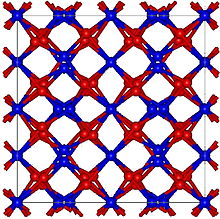This is an old revision of this page, as edited by 71.146.71.111 (talk) at 20:31, 5 August 2011. The present address (URL) is a permanent link to this revision, which may differ significantly from the current revision.
Revision as of 20:31, 5 August 2011 by 71.146.71.111 (talk)(diff) ← Previous revision | Latest revision (diff) | Newer revision → (diff)
| |
| Names | |
|---|---|
| IUPAC name Yttrium(II) oxide. | |
| Other names
Yttria, diyttrium trioxide, yttrium sesquioxide | |
| Identifiers | |
| CAS Number | |
| ECHA InfoCard | 100.013.849 |
| RTECS number |
|
| CompTox Dashboard (EPA) | |
| Properties | |
| Chemical formula | Y2O3 |
| Molar mass | 225.81 g/mol |
| Appearance | White solid. |
| Density | 5.010 g/cm³, solid |
| Melting point | 2425 °C |
| Boiling point | 4300 °C |
| Solubility in water | insoluble |
| Solubility in alcohol acid |
soluble |
| Structure | |
| Crystal structure | Cubic (bixbyite), cI80 |
| Space group | Ia-3, No. 206 |
| Coordination geometry | Octahedral |
| Related compounds | |
| Other cations | Scandium(III) oxide, Lanthanum(III) oxide |
| Except where otherwise noted, data are given for materials in their standard state (at 25 °C , 100 kPa).
| |
Yttrium oxide is Y2O3. It is an air-stable, white solid substance. Yttrium oxide is used as a common starting material for both materials science as well as inorganic compounds.
Uses
Materials science
It is the most important yttrium compound and is widely used to make YVO4 europium and Y2O3 europium phosphors that give the red color in color TV picture tubes. Yttrium oxide is also used to make yttrium iron garnets, which are very effective microwave filters.
Y2O3 is used to make the high temperature superconductor YBa2Cu3O7, known as "1-2-3" to indicate the ratio of the metal constituents:
- 2 Y2O3 + 8 BaO + 12 CuO + O2 → 4 YBa2Cu3O7
This synthesis is typically conducted at 800 °C.
The thermal conductivity of yttrium oxide is 27 W/(m·K).
Inorganic synthesis
Yttrium oxide is an important starting point for inorganic compounds. For organometallic chemistry it is converted to YCl3 in a reaction with concentrated hydrochloric acid and ammonium chloride.
Lasers
Y2O3 ceramics is a prospective solid-state laser material. In particular, lasers with ytterbium as dopant allow the efficient operation both in cw operation and in pulsed regimes. At high concentration of excitations (of order of 1%) and poor cooling, the quenching of emission at laser frequency and avalanche broadband emission takes place.
References
- Yong-Nian Xu; Zhong-quan Gu; W. Y. Ching (1997). "Electronic, structural, and optical properties of crystalline yttria". Phys. Rev. B56 (23): 14993–15000. doi:10.1103/PhysRevB.56.14993.
{{cite journal}}: CS1 maint: multiple names: authors list (link) - P. H. Klein and W. J. Croft (1967). "Thermal conductivity , Diffusivity, and Expansion of Y2O3, Y3Al5O12, and LaF3 in the Range 77-300 K". J. Appl. Phys. 38 (4): 1603. doi:10.1063/1.1709730.
- J. Kong (2005). "9.2-W diode-pumped Yb:Y2O3 ceramic laser". Applied Physics Letters. 86 (16): 161116. Bibcode:2005ApPhL..86p1116K. doi:10.1063/1.1914958.
{{cite journal}}: Unknown parameter|coauthors=ignored (|author=suggested) (help) - M.Tokurakawa (2007). "Diode-pumped 188 fs mode-locked Yb:Y2O3 ceramic laser". Appl.Phys.Lett. 90 (7): 071101. Bibcode:2007ApPhL..90g1101T. doi:10.1063/1.2476385.
{{cite journal}}: Unknown parameter|coauthors=ignored (|author=suggested) (help) - J.-F.Bisson (2007). "Switching of emissivity and photoconductivity in highly doped Yb:Y2O3 and Lu2O3 ceramics". Appl.Phys.Lett. 90 (20): 201901. doi:10.1063/1.2739318.
{{cite journal}}: Unknown parameter|coauthors=ignored (|author=suggested) (help)
External links
| Yttrium compounds | |||
|---|---|---|---|
| Yttrium(II) | |||
| Yttrium(III) |
| ||
This inorganic compound–related article is a stub. You can help Misplaced Pages by expanding it. |